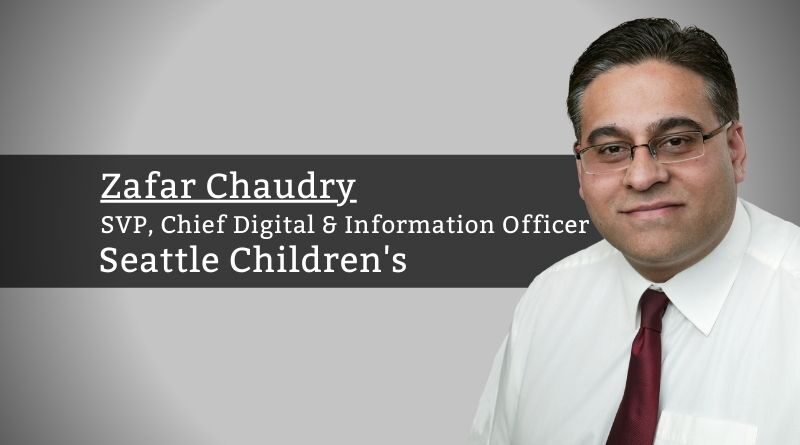Why Moving the EMR to the Cloud Is the Next Natural Evolution
By Zafar Chaudry, MD, MS, MIS, MBA, SVP, Chief Digital & Information Officer, Seattle Children’s
The need for agile IT infrastructure has never been greater. Two years into the pandemic, healthcare IT leaders face numerous challenges and increasing pressure to be more responsive to changes in care access and delivery. This is compounded by declining healthcare delivery organization (HDO) margins, cost improvement programs, lack of available SMEs, rising costs and supply chain issues. All of these are drivers for rethinking how IT services should be delivered in the future.
HDO technology professionals must remember they are in the business of delivering patient care, not IT. IT staff need to focus on how their subject matter expertise can support patient care and move away from core technology functions such as infrastructure and hosting. This is coming to life in many HDOs as a cloud-first strategy.
Identifying the Catalyst for the Cloud
The move to a cloud-based EMR was a key part of Seattle Children’s digital transformation strategy. We needed to unify and simplify our systems, be fortified to consume applications at a faster pace, promote seamless security, and make our system more agile and accessible. It was also critical our entire staff could access the EMR application at the point of care, anywhere at any time. These needs were heightened by the pandemic and a cloud-based system offered a myriad of benefits, including:
- Offloading responsibilities to the service provider (with a cloud-based managed EMR model), freeing up internal IT staff to deliver more innovation and focus on patient care initiatives.
- Building a technology platform that is future-proof and allows hosting of Epic applications and systems, as well as third-party ancillary and supporting applications that run alongside it.
- Maintaining high application availability and performance.
- Eliminating the need for in-house technical Epic SMEs to manage the system.
- Achieving predictable capped costs per year for the managed service and hosting.
- Maintaining a strong security posture and HIPAA-HITECH compliance.
On October 3, 2020, while navigating the pandemic, we replaced two highly customized EMR systems with a standard set of pediatric tools. We implemented an integrated EHR with Epic across 46 sites in four states. This was Seattle Children’s largest undertaking in the last 15 years and a momentous step forward to helping us provide the best possible care to every patient and their family.
We learned that demonstrating and communicating how the change will impact the IT team was a critical component for better change management and buy-in.
Changing the Culture
Implementing an enterprise-wide information system, such as a new EMR, is a major change project with a significant cost, which should not be underestimated. Moving to the cloud directly impacts IT staff, who will inevitably resist losing control of directly managing infrastructure they are familiar with. Early IT staff engagement outlining the upcoming changes and a good communication plan is important. In addition, having a well-defined process, some important milestones should be part of your framework: Building a business case, identifying the key considerations for your specific organization, and including your security team in the reviews. While many of these steps might seem obvious, when done right, you will gain credibility with your key stakeholders and simplify your approval process when it comes time to get funding for a project of this size.
In any project, there are always some failures; communication and engagement were areas we did not focus enough of our energy on. We learned that demonstrating and communicating how the change will impact the IT team was a critical component for better change management and buy-in.
When deciding on which vendor to select, we evaluated the costs and options for hosting with the internal IT team and two vendors, Epic and Virtustream (Dell). We explored fixed costs (per year), guaranteed service levels for availability and performance (with financial penalties), vendor size and capability, Epic certifications and subject matter expertise, track record of delivery, availability of a dedicated service desk, ServiceNow integration, green data centers, contractual flexibility, and the ability to connect data centers via multi-vendor, large bandwidth, dual resilient and diverse network circuits. With these criteria, we chose Virtustream (Dell) as our partner to host and fully manage the EMR.
Realizing the Benefits
Seattle Children’s hosted system has been live for over 18 months. Some of the benefits delivered include:
- Consistently exceeding uptime of 99.995%.
- One of our two data centers is 100% solar powered.
- Service levels at the infrastructure level for the cloud environment are backed by financial penalties.
- Log-in times, performance and user experience have improved compared to on-premises, and changes are delivered in days versus months.
- Epic upgrades are completed in 40 minutes versus 4 hours previously.
- The speed and ability to scale up and perform change control on the cloud environment improved. Changes can be made in days versus months.
- Costs are now predictable and future-proofed against increases with a shift from capital to operating expenditure.
- More advanced disaster recovery capability.
- Seamless integration with ServiceNow minimizes manual cycles for the staff while improving response times and reducing errors.
Considerations for Adopting a Cloud-Based EMR
As a starting place, organizations who are contemplating a move of their EMR to the cloud should:
- Inventory, review and refresh all your third-party applications and contracts.
- Develop a strong communication plan. Focus energy on change management.
- Build and manage the relationship. Your cloud provider needs to be a trusted advisor. Be diligent in the evaluation and select people-minded people. Retrain existing internal IT staff to manage the vendor rather than implementing the infrastructure.
- Properly prepare for contracting; it is time-consuming. Get an appropriate expert legal counsel to ensure that the terms and conditions and service level agreements are guaranteed and backed by financial penalties.
- Check the network bandwidth between data centers and ensure all network circuits are multi-vendor, dual, resilient and follow diverse routes.
- Guarantee flexibility. Work with a vendor who can adjust as plans change and is flexible, quick to respond and willing to negotiate terms.
- Ensure that the vendor has the right Epic certifications and SMEs, has a track record of delivery, provides a 24×7 dedicated service desk and integrates with your service desk ticketing system.



